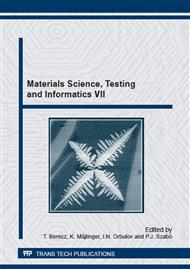p.71
p.77
p.83
p.89
p.95
p.101
p.107
p.113
p.119
Development of Ceramic Feedstock for Powder Injection Molding
Abstract:
As part of our technology development program we started to prepare for introducing ceramic injection molding technology. The technology consists of the following steps: 1. feedstock preparation (mixing the ceramic powder with binding agent), 2. injection molding (green body production), 3. thermal or solvent debinding (brown body production), 4. sintering of the brown body. To make alumina ceramic parts essential to know the properties of all raw materials which are used during the PIM process. That is why this article is focused on the thermogravimetric studies of potential raw materials. These thermogravimetric studies helped to optimize the debinding experiments at specimens with high alumina content. First of all the measured curves of the feedstock were compared with calculated curves from the single raw materials. This comparison helped us to understand the processes in the feedstock during the sintering. Then thermogravimetric experiments in air atmosphere were made to optimize the sintering process. These experiments resulted good structural properties at the sintered parts.
Info:
Periodical:
Pages:
95-99
Citation:
Online since:
February 2015
Authors:
Keywords:
Price:
Сopyright:
© 2015 Trans Tech Publications Ltd. All Rights Reserved
Share:
Citation:


